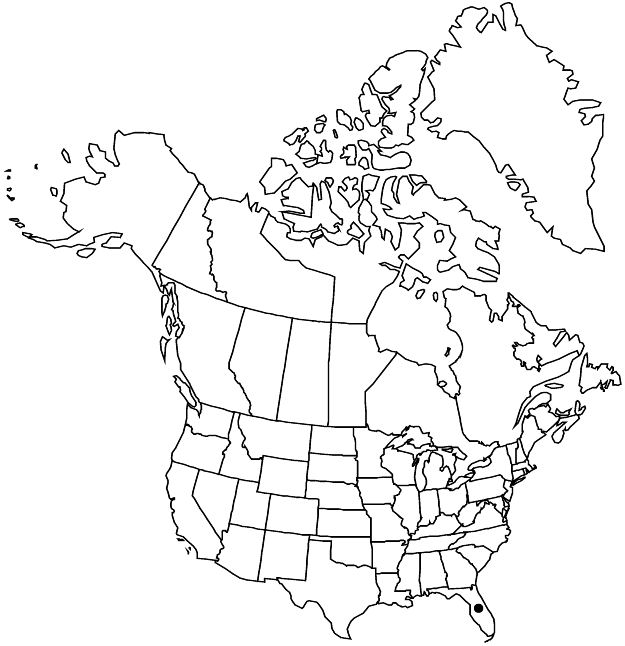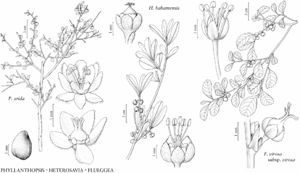Difference between revisions of "Heterosavia bahamensis"
Brittonia 60: 153. 2008.
FNA>Volume Importer |
imported>Volume Importer |
||
| (6 intermediate revisions by 2 users not shown) | |||
| Line 10: | Line 10: | ||
|special_status={{Treatment/ID/Special_status | |special_status={{Treatment/ID/Special_status | ||
|code=F | |code=F | ||
| − | |label= | + | |label=Illustrated |
}} | }} | ||
| − | |basionyms={{Treatment/ID/ | + | |basionyms={{Treatment/ID/Basionym |
|name=Savia bahamensis | |name=Savia bahamensis | ||
|authority=Britton | |authority=Britton | ||
| + | |rank=species | ||
| + | |publication_title=Torreya | ||
| + | |publication_place=4: 104. 1904 | ||
}} | }} | ||
|synonyms= | |synonyms= | ||
| Line 31: | Line 34: | ||
|elevation=0–10 m. | |elevation=0–10 m. | ||
|distribution=Fla.;West Indies (Greater Antilles). | |distribution=Fla.;West Indies (Greater Antilles). | ||
| − | |discussion=<p>Heterosavia bahamensis is restricted in the flora area to the lower Florida Keys, where it may be locally abundant, forming monospecific thickets.</p> | + | |discussion=<p><i>Heterosavia bahamensis</i> is restricted in the flora area to the lower Florida Keys, where it may be locally abundant, forming monospecific thickets.</p> |
|tables= | |tables= | ||
|references= | |references= | ||
| Line 40: | Line 43: | ||
-->{{#Taxon: | -->{{#Taxon: | ||
name=Heterosavia bahamensis | name=Heterosavia bahamensis | ||
| − | |||
|authority=(Britton) Petra Hoffmann | |authority=(Britton) Petra Hoffmann | ||
|rank=species | |rank=species | ||
| Line 54: | Line 56: | ||
|publication title=Brittonia | |publication title=Brittonia | ||
|publication year=2008 | |publication year=2008 | ||
| − | |special status= | + | |special status=Illustrated |
| − | |source xml=https:// | + | |source xml=https://bitbucket.org/aafc-mbb/fna-data-curation/src/2e0870ddd59836b60bcf96646a41e87ea5a5943a/coarse_grained_fna_xml/V12/V12_604.xml |
|genus=Heterosavia | |genus=Heterosavia | ||
|species=Heterosavia bahamensis | |species=Heterosavia bahamensis | ||
Latest revision as of 19:16, 5 November 2020
Shrubs or trees, (5–)20–40(–80) dm. Leaves: petiole 2–5(–8) mm; blade usually obovate or elliptic, sometimes oblong, (1–)2–4.5(–8) × (0.7–)1.2–2.5(–4.5) cm, base acute, obtuse, or rounded, apex acute, obtuse, rounded, truncate, or retuse, surfaces usually glabrous, sometimes with scattered hairs. Inflorescences: staminate flowers (6–)10–25 per glome. Pedicels: pistillate 1–6 mm. Staminate flowers: sepals ovate or oblong, 1.5–2 mm, hairy abaxially, sometimes ciliate; petals spatulate to obdeltate, 1–1.5 mm, margins erose to lacerate, apex truncate; stamens 2–4 mm. Pistillate flowers: sepals orbiculate, ovate, or deltate, 1–2 mm, hairy abaxially, sometimes ciliate; petals spatulate to orbiculate or oblong, 1–2 mm, entire to slightly erose, sometimes ciliate. Capsules 6–7(–9) mm diam. Seeds brown to reddish, 3–5.5 mm.
Phenology: Flowering and fruiting year-round.
Habitat: Hammocks, limestone.
Elevation: 0–10 m.
Distribution

Fla., West Indies (Greater Antilles).
Discussion
Heterosavia bahamensis is restricted in the flora area to the lower Florida Keys, where it may be locally abundant, forming monospecific thickets.
Selected References
None.
